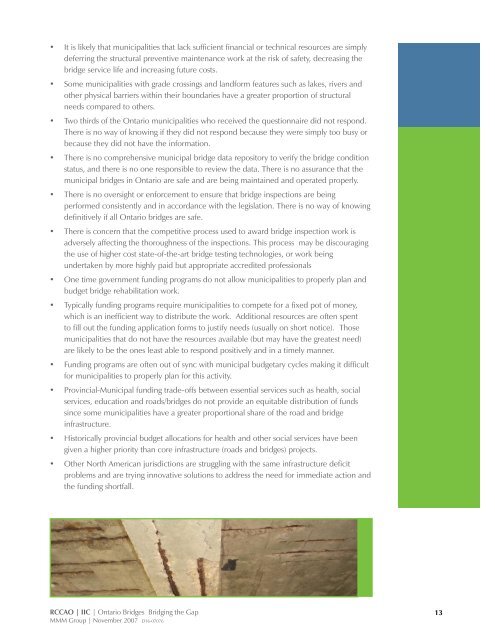ONTARIO'S BRIDGES - BRIDGING THE GAP - Complete ... - rccao
ONTARIO'S BRIDGES - BRIDGING THE GAP - Complete ... - rccao
ONTARIO'S BRIDGES - BRIDGING THE GAP - Complete ... - rccao
- No tags were found...
Create successful ePaper yourself
Turn your PDF publications into a flip-book with our unique Google optimized e-Paper software.
• It is likely that municipalities that lack sufficient financial or technical resources are simplydeferring the structural preventive maintenance work at the risk of safety, decreasing thebridge service life and increasing future costs.• Some municipalities with grade crossings and landform features such as lakes, rivers andother physical barriers within their boundaries have a greater proportion of structuralneeds compared to others.• Two thirds of the Ontario municipalities who received the questionnaire did not respond.There is no way of knowing if they did not respond because they were simply too busy orbecause they did not have the information.• There is no comprehensive municipal bridge data repository to verify the bridge conditionstatus, and there is no one responsible to review the data. There is no assurance that themunicipal bridges in Ontario are safe and are being maintained and operated properly.• There is no oversight or enforcement to ensure that bridge inspections are beingperformed consistently and in accordance with the legislation. There is no way of knowingdefinitively if all Ontario bridges are safe.• There is concern that the competitive process used to award bridge inspection work isadversely affecting the thoroughness of the inspections. This process may be discouragingthe use of higher cost state-of-the-art bridge testing technologies, or work beingundertaken by more highly paid but appropriate accredited professionals• One time government funding programs do not allow municipalities to properly plan andbudget bridge rehabilitation work.• Typically funding programs require municipalities to compete for a fixed pot of money,which is an inefficient way to distribute the work. Additional resources are often spentto fill out the funding application forms to justify needs (usually on short notice). Thosemunicipalities that do not have the resources available (but may have the greatest need)are likely to be the ones least able to respond positively and in a timely manner.• Funding programs are often out of sync with municipal budgetary cycles making it difficultfor municipalities to properly plan for this activity.• Provincial-Municipal funding trade-offs between essential services such as health, socialservices, education and roads/bridges do not provide an equitable distribution of fundssince some municipalities have a greater proportional share of the road and bridgeinfrastructure.• Historically provincial budget allocations for health and other social services have beengiven a higher priority than core infrastructure (roads and bridges) projects.• Other North American jurisdictions are struggling with the same infrastructure deficitproblems and are trying innovative solutions to address the need for immediate action andthe funding shortfall.RCCAO | IIC | Ontario Bridges Bridging the GapMMM Group | November 2007 D16-0707613



